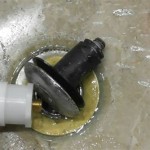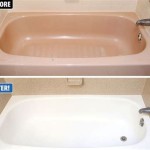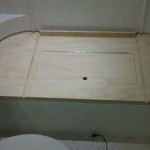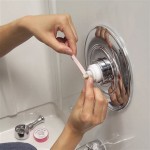How To Remove Caulking From a Fiberglass Bathtub
Removing old or damaged caulking from a fiberglass bathtub is a necessary maintenance task for homeowners. Over time, caulk can become cracked, discolored, and harbor mold and mildew, compromising its ability to provide a watertight seal. This can lead to water damage behind the bathtub, potentially causing costly repairs. While the process requires patience and care, understanding the correct methods and tools can ensure a clean and effective removal without damaging the fiberglass surface.
Before embarking on the removal process, it's important to assess the condition of the existing caulk and gather the necessary supplies. This preliminary step helps to streamline the process and minimizes the risk of complications. A thorough inspection will reveal the extent of the damage, the type of caulk used (silicone or latex), and any areas where the caulk is particularly difficult to remove. Gathering the appropriate tools beforehand will also prevent unnecessary delays and ensure that the work can be completed efficiently.
Preparing for Caulk Removal
Preparation is paramount to successful caulk removal, especially when working with a relatively delicate material like fiberglass. The goal is to soften the caulk and protect the surrounding area from scratches or damage. The first step involves ensuring adequate ventilation in the bathroom. Opening windows and turning on the exhaust fan helps to dissipate any fumes from cleaning agents or caulk softeners that may be used.
Next, the bathtub and surrounding surfaces should be thoroughly cleaned. This removes any loose dirt, grime, or soap scum that could interfere with the caulk removal process. Using a mild detergent and a soft sponge or cloth is recommended to avoid scratching the fiberglass. Rinse the area thoroughly with clean water and allow it to dry completely. This ensures that the caulk softener or removal agent can penetrate the caulk effectively.
Protecting the surrounding area is also crucial. Apply painter's tape along the edges of the bathtub and the adjacent wall or tile. This creates a barrier that prevents accidental scratches or damage to these surfaces during the caulk removal process. The painter's tape should be applied carefully and snugly to ensure a clean and precise line. This will also aid in applying the new caulk later on.
Softening the Caulking
Softening the caulk is a critical step in facilitating its removal. Hardened caulk can be difficult to remove in large pieces and is more likely to leave behind stubborn residue. Several methods can be used to soften the caulk, each with its own advantages and disadvantages.
One common method is to use a commercially available caulk softener. These products are specifically formulated to break down the chemical bonds in caulk, making it easier to remove. Follow the manufacturer's instructions carefully when applying the caulk softener. Generally, the product is applied directly to the caulk and allowed to sit for a specified period of time, typically 15-30 minutes. After the allotted time, the caulk should be noticeably softer and more pliable.
Another method involves using heat to soften the caulk. A hairdryer can be used to gently heat the caulk, making it more pliable. Hold the hairdryer a few inches away from the caulk and move it back and forth to avoid overheating any one area. Be cautious not to hold the hairdryer too close to the fiberglass, as excessive heat can damage the surface. Alternatively, a heat gun can be used, but it must be used with extreme caution due to its higher heat output. It's recommended to practice using the heat gun on a scrap piece of material first to get a feel for the appropriate distance and heat level.
For a more natural approach, a mixture of vinegar and baking soda can be used. Apply a paste of vinegar and baking soda to the caulk and let it sit for several hours or overnight. The acidic properties of the vinegar will help to break down the caulk, while the baking soda will provide a mild abrasive action. This method is less potent than commercial caulk softeners but is a good option for individuals sensitive to chemicals.
Removing the Caulking
Once the caulk has been sufficiently softened, the actual removal process can begin. This requires the use of appropriate tools and techniques to minimize the risk of damage to the fiberglass bathtub.
A specialized caulk removal tool is often the best option. These tools are designed with a sharp, angled blade that can easily slide under the caulk and lift it away from the surface. Hold the tool at a slight angle and gently push it along the caulk line, using a steady and controlled motion. Avoid applying excessive pressure, as this can scratch or gouge the fiberglass. Work in small sections, removing the caulk gradually, and be patient. Rushing the process can lead to mistakes and potentially damage the tub.
If a caulk removal tool is not available, a utility knife or a plastic putty knife can be used. Exercise extreme caution when using a utility knife, as the sharp blade can easily slip and cause injury or damage to the fiberglass. Hold the knife at a shallow angle and use a sawing motion to slice through the caulk along the edges. A plastic putty knife is a safer option, as it is less likely to scratch the surface. However, it may require more force to remove the caulk, especially if it is heavily hardened.
After removing the bulk of the caulk, there will likely be some residual caulk remaining on the surface. This residue can be removed using a variety of methods. A plastic scraper can be used to gently scrape away the remaining caulk. A soft cloth dampened with mineral spirits or rubbing alcohol can also be used to dissolve the residue. Always test the solvent in an inconspicuous area first to ensure that it does not damage the fiberglass.
Stubborn caulk residue may require more aggressive methods. A mild abrasive cleaner, such as baking soda paste, can be used to gently scrub the surface. Avoid using harsh abrasive cleaners or scouring pads, as these can scratch the fiberglass. For particularly difficult residue, a heat gun can be used cautiously to soften the caulk before scraping it away. However, exercise extreme care to avoid overheating the fiberglass.
Once all of the caulk and residue have been removed, thoroughly clean the area with a mild detergent and water. Rinse the area thoroughly and allow it to dry completely before applying new caulk. Inspect the area for any scratches or damage and repair them as needed before proceeding.
Applying New Caulking
After the old caulk has been completely removed and the area has been thoroughly cleaned and dried, the final step is to apply new caulk. This step is crucial for creating a watertight seal and preventing water damage. The selection of the right type of caulk and the proper application technique are essential for long-lasting results.
When choosing caulk for a fiberglass bathtub, it is important to select a product that is specifically formulated for use in bathrooms and kitchens. These caulks are typically mildew-resistant and waterproof, providing a durable and long-lasting seal. Silicone caulk is a popular choice for bathrooms due to its excellent water resistance and flexibility. Latex caulk is also a viable option, but it is not as resistant to water and mildew as silicone caulk.
Before applying the caulk, ensure that the area is completely dry. Use a caulk gun to apply a bead of caulk along the joint between the bathtub and the wall or tile. Maintain a consistent pressure on the caulk gun to ensure a smooth and even bead. Avoid applying excessive caulk, as this can create a messy and unprofessional appearance.
After applying the caulk, use a wet finger or a caulk smoothing tool to smooth the bead and create a clean, professional finish. Dipping the finger or tool in water will prevent the caulk from sticking. Wipe away any excess caulk with a damp cloth. Allow the caulk to dry completely according to the manufacturer's instructions before using the bathtub.
Proper maintenance of the caulk will help to extend its lifespan and prevent the growth of mold and mildew. Regularly clean the caulk with a mild detergent and water. Avoid using harsh chemicals or abrasive cleaners, as these can damage the caulk. Inspect the caulk periodically for any signs of damage, such as cracks or discoloration, and repair or replace it as needed.

Removing Silicone Caulk Adhesive Residue After Taking Out Shower Doors Fiberglass Tub Enclosure Vid

How To Diy Remove 100 Silicone Caulk Old Stubborn Stuck The Fiberglass Shower Tub Pan Base
How To Remove Silicone Caulk From Fibreglass Shower Stalls

Removing A Fiberglass Bath And Surround

How To Remove Silicone Caulk From Fibreglass Shower Stalls

Remove Silicone Caulk With Mineral Spirits Restoring A 30 Year Old Fiberglass Tub

How To Remove Caulk Ace Hardware

Easily Remove Silicone Caulk Without Chemicals

How To Re Caulk A Shower Dap Global

How To Caulk A Bathtub 13 Steps With Pictures Wikihow
Related Posts








